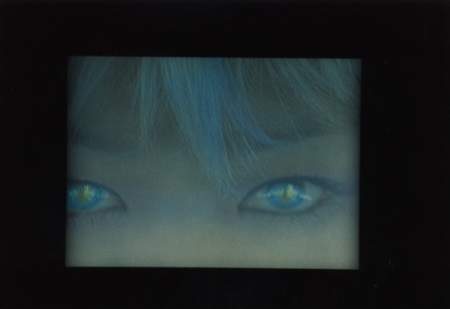Mariko Mori:
Empty Dream
Brooklyn Museum of
Art
April 8 to August 15, 1999
I love reading the reactions to Mariko Mori’s shows
around the world. On her last
exhibition at the Serpentine Gallery in London, a critic
from The Guardian wasted half
a page of the paper just to conclude that her work is
self obsessed and narcissistic. The
Village Voice now complained that she doesn’t invent her own mythology (as
Matthew Barney does) but uses Asian religions to express her spirituality, and
furthermore she makes use of assistants
to produce her works. Artists portray themselves and
their vision of the world.
Contemporary artists have assistants to do a lot of their
manual works. This is what artists
do. I don’t think this would be an issue if Mariko Mori wasn’t extremely
beautiful, wealthy and Japanese. Somehow the combination of these three elements make
up a reason to judge her and her work as superficial, naive and mundane.
Empty Dream (1995),
a 9x24 feet six panels photograph, shows a scene from
Ocean Dome, the largest indoor
artificial beach in the world. Here Mariko depicts herself four times posing dressed
up as a mermaid. A friend of mine compared this work to “La Grande
Jatte” by Seurat, and I think this is the very key we need to use to open the door
to the fantasy world of Mariko Mori. Pondering on this, I could not think
of a more suitable work of art to represent this moment in time, the end of
this century and the end of this millennium. Mariko’s world may be
superficial and immediate, but it’s the mirror of a culture that is pointing in
this direction, towards an empty dream of artificial happiness that cannot
last.
Whilst looking at her video installation Miko
No Inori, filmed at Kansai
International Airport, I have been
wondering on where she could go from here and I imagined a huge architectural
installation of her sci-fi future world where spectators can enter the space. Then
I thought of the disappointment I would experience in meeting a normal human
being in this environment. I think
a very important aspect of Mori’s work can be
understood the moment we step
out of her world and we are back into the real one. Her
world is not a fantasy dream,
it what the real world could be. It’s not by chance
she placed an earlier
photograph, Play with me, at the entrance/exit of the exhibition. In this she portrays herself
standing in front of a Japanese game arcade, wearing an anime high tech
silver armour. When we see this photograph before the exhibition it works
as a prologue to what we are about to enter, but looking at it again before
we exit, a sudden sadness reminds us of the reality of our society, its need
for diversion and artificial achievements
to overcome spiritual and philosophical emptiness. Her
face is uncertain, like a
robot doll or a video game prostitute, she waits for her
next nickel dropper and wonders what
he will be like. In the last
few years, Mariko Mori has moved from works reflecting on
the state of our society, to
a quest of a more spiritual nature. In a series of four large photographic
panoramas, Esoteric Cosmos (1996 - 98),
Mori presents herself within a dreamy, perfectly
digitally composed, landscapes:
Entropy of Love, Burning Desire, Mirror of
Water, and Pure Land. They
symbolise the four elements of Nature as defined by
Buddhist teaching. Burning Desire is the most intriguing of the four
panels: shot on the Goby desert,
Mariko is present four times wearing traditional Tibetan
clothes, levitating and
burning. A fifth deity floats above them spreading a
rainbow of light around her:
it's goddess Mariko, giving a message of faith and
support for the Tibetan cause for
freedom.
In one of her most recent works, Kumano (1998) we see her, with her usual beauty and grace, run in the forest,
perform Shinto rituals and the tea ceremony inside a futuristic digitally
produced surrounding. The video is accompanied by music that she has composed
and sings, and takes us into a dream where the future is now but
tradition is respected and seen in a new light of serenity and enlightenment. She
herself invited Brooklyn to assist her tea ceremony. In a slow ritual,
surrounded by suitable ambient music, she placed white sand and flower petals on
the floor, then distributed colourful
crystal balls on the sand to symbolise our cosmos, thus
making, for a moment, the
Brooklyn Museum into the centre of the universe. She then
knelt into a transparent tent to
perform the traditional Japanese tea ceremony and disappeared into the silent
crowd.
To many, Mariko Mori's message can be seen as naive and
superficial, fuelled by her
wealth and fashionable style. To me, she's a genuine
artist capable of combining
new technology and traditional - artistic and spiritual -
values into a perfect marriage of
beauty and honesty.
(c) Stefano Pasquini 1999
